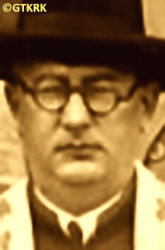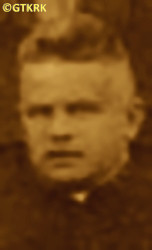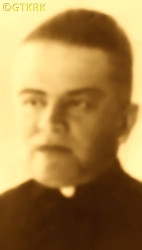Roman Catholic
St Sigismund parish
05-507 Słomczyn
85 Wiślana Str.
Konstancin deanery
Warsaw archdiocese, Poland
full list:
displayClick to display full list

searchClick to search full list by categories
wyświetlKliknij by wyświetlić pełną listę po polsku

szukajKliknij by przeszukać listę wg kategorii po polsku

Martyrology of the clergy — Poland
XX century (1914 – 1989)
personal data
surname
MIODUSZEWSKI
forename(s)
Anthony (pl. Antoni)
function
diocesan priest
creed
Latin (Roman Catholic) Church RCmore on
en.wikipedia.org
[access: 2014.09.21]
diocese / province
Siedlce diocesemore on
en.wikipedia.org
[access: 2022.01.06]
Janów Podlaski diocesemore on
www.catholic-hierarchy.org
[access: 2021.12.19]
Lutsk‐Zhytomyr diocese (aeque principaliter)more on
www.catholic-hierarchy.org
[access: 2021.12.19]
RC Military Ordinariate of Polandmore on
en.wikipedia.org
[access: 2014.12.20]
honorary titles
honorary canonmore on
honorary canon
(1941)
„Pro Ecclesia et Pontifice”more on
„Pro Ecclesia et Pontifice”
(c. 1932)
date and place
of death
28.07.1944

Krześlintoday: Suchożebry gm., Siedlce pov., Masovia voiv., Poland
more on
en.wikipedia.org
[access: 2021.05.06]
details of death
In 1898 accepted to the Seminary in Lublin, but did not obtain the consent of the occupying Russian authorities (partitions of Poland). Moved to Zhytomyr.
In 1909, deprived of the position of administrator (parish priest) of the Kuniv parish, by the ruling of an administrative court of the occupying Russian authorities, with a ban on taking up similar positions. Was able to take up the position of parish priest years later, during World War I, after the fall of tsarism in Russia in 03.1917.
In 1918, after the separatist peace treaty between the Central Powers (Germany, Austria–Hungary) and Bolshevik Russia, signed on 03.03.1918 in Brest, returned to his home village and his home diocese.
According to some sources, in 1920, during the Polish–Russian War of 1919‐1921, when the Russian offensive that began in 05.1920 was approaching the center of Poland, served as an auxiliary chaplain in Biała Podlaska. As a result of a major battle of 02‐08.08.1920, the Russians occupied Biała Podlaska on 09.08.1920. A few days later, on 12.08.1920, the Russians advanced further west and captured Siedlce and his Krześlin village, located c.8 km away, where ministered. Three days later, on c. 15.08.1920, the great Battle of Warsaw began (known as the „Miracle on the Vistula”), in which the Polish Army defeated the Russian offensive and on 18.08.1920, recaptured Siedlce (and therefore Krześlin), and a day earlier, on 18.08.1920, Biała Podlaska.
After the German and Russian attack on Poland in 09.1939 and the start of World War II, after the German attack on 22.06.1941 on their erstwhile ally, the Russians, at the end of the German occupation, when the Russian front approached the centre of Poland — after the German defeat during the great Russian offensive, known as Rus. Операция Багратион (Eng. Operation Bagration), which led to the almost complete destruction of German troops in Lithuania, Belarus and eastern Poland — the Russians reached Siedlce as part of the Rus. Люблин–Брестская операция (Eng. Brest–Lublin Operation) on 24.07.1944. Prob. on the same day Russians entered his parish Krześlin. The battle for Siedlce began and lasted till 31.08.1944.
Perished during it. When was returning from a visit to the sick, carried the burse containing the Body of the Lord to the parish church. When leaving it, was hit by a fragment of a shell that exploded in the church.
It is not clear which side fired it — it seems more likely that Germans did it, digging in to defend their positions in Siedlce and to the west of that city.
cause of death
warfare
perpetrators
Germans / Russians
sites and events
GeneralgouvernementClick to display the description, Ribbentrop‐MolotovClick to display the description, Pius XI's encyclicalsClick to display the description, Polish‐Russian war of 1919‐1921Click to display the description
date and place
of birth
16.06.1880Birth certification on:
photos.szukajwarchiwach.gov.pl
[access: 2025.08.19]

Krześlintoday: Suchożebry gm., Siedlce pov., Masovia voiv., Poland
more on
en.wikipedia.org
[access: 2021.05.06]
parents
MIODUSZEWSKI Paul
🞲 ?, ? — 🕆 ?, ?

PROTASIUK Catherine
🞲 ?, ? — 🕆 ?, ?
baptism
17.06.1880Birth certification on:
photos.szukajwarchiwach.gov.pl
[access: 2025.08.19]

Suchożebrytoday: Suchożebry gm., Siedlce pov., Masovia voiv., Poland
more on
en.wikipedia.org
[access: 2021.05.06]
St Mary Magdalene RC church
presbyter (holy orders)
ordination
1905

Sankt Petersburgtoday: Saint Petersburg city, Russia
more on
en.wikipedia.org
[access: 2020.07.31]
positions held
1929 – 1944
parish priest — Krześlintoday: Suchożebry gm., Siedlce pov., Masovia voiv., Poland
more on
en.wikipedia.org
[access: 2021.05.06] ⋄ St Nicholas the Bishop and Confessor RC parish ⋄ Siedlcetoday: Siedlce city pov., Masovia voiv., Poland
more on
en.wikipedia.org
[access: 2021.08.20] RC deanery — also: inspector of religion classes in elementary schools in Siedlce deanery (c. 1929‐1931)
1924 – 1929
parish priest — Prostyńtoday: Małkinia Górna gm., Ostrów Mazowiecka pov., Masovia voiv., Poland
more on
en.wikipedia.org
[access: 2024.12.13] ⋄ Holy Trinity RC parish ⋄ Węgrówtoday: Węgrów urban gm., Węgrów pov., Masovia voiv., Poland
more on
en.wikipedia.org
[access: 2021.08.20] RC deanery
1922 – 1924
dean — Włodawatoday: Włodawa urban gm., Włodawa pov., Lublin voiv., Poland
more on
en.wikipedia.org
[access: 2021.12.18] RC deanery
1922 – 1924
parish priest — Włodawatoday: Włodawa urban gm., Włodawa pov., Lublin voiv., Poland
more on
en.wikipedia.org
[access: 2021.12.18] ⋄ St Louis the King and Confessor RC parish ⋄ Włodawatoday: Włodawa urban gm., Włodawa pov., Lublin voiv., Poland
more on
en.wikipedia.org
[access: 2021.12.18] RC deanery — also: auxilliary chaplain of the Włodawa garrison of the Polish Army
1922
parish priest — Hołublatoday: Paprotnia gm., Siedlce pov., Masovia voiv., Poland
more on
en.wikipedia.org
[access: 2024.12.13] ⋄ Nativity of the Blessed Virgin Mary RC parish ⋄ Siedlcetoday: Siedlce city pov., Masovia voiv., Poland
more on
en.wikipedia.org
[access: 2021.08.20] RC deanery
1919 – 1922
parish priest — Krześlintoday: Suchożebry gm., Siedlce pov., Masovia voiv., Poland
more on
en.wikipedia.org
[access: 2021.05.06] ⋄ St Nicholas the Bishop and Confessor RC parish ⋄ Siedlcetoday: Siedlce city pov., Masovia voiv., Poland
more on
en.wikipedia.org
[access: 2021.08.20] RC deanery
1918 – 1919
parish priest — Niemojkitoday: Łosice gm., Łosice pov., Masovia voiv., Poland
more on
en.wikipedia.org
[access: 2022.01.10] ⋄ St Peter and St Paul the Apostles RC parish ⋄ Łosicetoday: Łosice gm., Łosice pov., Masovia voiv., Poland
more on
en.wikipedia.org
[access: 2021.08.20] RC deanery
c. 1917 – 1918
dean — Iziaslav‐Ostrohdeanery name
today: Ukraine RC deanery
c. 1917 – 1918
parish priest — Ostrohtoday: Ostroh urban hrom., Rivne rai., Rivne obl., Ukraine
more on
en.wikipedia.org
[access: 2021.09.17] ⋄ Assumption of the Blessed Virgin Mary RC parish ⋄ Iziaslav‐Ostrohdeanery name
today: Ukraine RC deanery
c. 1912 – 1917
curatus/rector/expositus — Shepetivkatoday: Shepetivka urban hrom., Shepetivka rai., Proskuriv/Khmelnytskyi obl., Ukraine
more on
en.wikipedia.org
[access: 2021.09.17] ⋄ RC chapel ⋄ Zaslavtoday: Iziaslav urban hrom., Shepetivka rai., Proskuriv/Khmelnytskyi obl., Ukraine
more on
en.wikipedia.org
[access: 2021.09.17], St Joseph Spouse of the Blessed Virgin Mary RC parish ⋄ Iziaslav‐Ostrohdeanery name
today: Ukraine RC deanery
c. 1910 – c. 1912
vicar — Felsztyntoday: Hvardiiske, Hvardiiske hrom., Proskuriv/Khmelnytskyi rai., Proskuriv/Khmelnytskyi obl., Ukraine
more on
uk.wikipedia.org
[access: 2023.03.02] ⋄ St Adalbert the Bishop and Martyr RC parish ⋄ Proskurivtoday: Khmelnytskyi, Proskuriv/Khmelnytskyi urban hrom., Proskuriv/Khmelnytskyi rai., Proskuriv/Khmelnytskyi obl., Ukraine
more on
en.wikipedia.org
[access: 2020.11.27] RC deanery
c. 1909 – c. 1910
curatus/rector/expositus — Mizochtoday: Mizoch hrom., Rivne rai., Rivne obl., Ukraine
more on
en.wikipedia.org
[access: 2022.07.05] ⋄ St John of Nepomuk the Martyr RC church ⋄ Ostrohtoday: Ostroh urban hrom., Rivne rai., Rivne obl., Ukraine
more on
en.wikipedia.org
[access: 2021.09.17], Assumption of the Blessed Virgin Mary RC parish ⋄ Iziaslav‐Ostrohdeanery name
today: Ukraine RC deanery
1908 – 1909
administrator — Kunivtoday: Iziaslav urban hrom., Shepetivka rai., Proskuriv/Khmelnytskyi obl., Ukraine
more on
uk.wikipedia.org
[access: 2023.03.02] ⋄ Assumption of the Blessed Virgin Mary RC parish ⋄ Iziaslav‐Ostrohdeanery name
today: Ukraine RC deanery
c. 1907 – c. 1908
vicar — Ostrohtoday: Ostroh urban hrom., Rivne rai., Rivne obl., Ukraine
more on
en.wikipedia.org
[access: 2021.09.17] ⋄ Assumption of the Blessed Virgin Mary RC parish ⋄ Iziaslav‐Ostrohdeanery name
today: Ukraine RC deanery — also: prefect of 8‐year Gymnasium for Boys
c. 1906 – c. 1907
vicar — Lityntoday: Lityn hrom., Vinnytsia rai., Vinnytsia obl., Ukraine
more on
en.wikipedia.org
[access: 2020.11.27] ⋄ Immaculate Conception of the Blessed Virgin Mary RC parish ⋄ Lityntoday: Lityn hrom., Vinnytsia rai., Vinnytsia obl., Ukraine
more on
en.wikipedia.org
[access: 2020.11.27] RC deanery
1905 – c. 1906
vicar — Letychivtoday: Letychiv hrom., Proskuriv/Khmelnytskyi rai., Proskuriv/Khmelnytskyi obl., Ukraine
more on
en.wikipedia.org
[access: 2021.09.17] ⋄ Assumption of the Blessed Virgin Mary RC parish ⋄ Letychivtoday: Letychiv hrom., Proskuriv/Khmelnytskyi rai., Proskuriv/Khmelnytskyi obl., Ukraine
more on
en.wikipedia.org
[access: 2021.09.17] RC deanery
1903 – 1905
student — Sankt Petersburgtoday: Saint Petersburg city, Russia
more on
en.wikipedia.org
[access: 2020.07.31] ⋄ philosophy and theology, Imperial Roman Catholic Spiritual Academy (1842‐1918)
1898 – 1903
student — Zhytomyrtoday: Zhytomyr urban hrom., Zhytomyr rai., Zhytomyr obl., Ukraine
more on
en.wikipedia.org
[access: 2021.09.17] ⋄ philosophy and theology, Theological Seminary
sites and events
descriptions
Generalgouvernement: After the Polish defeat in the 09.1939 campaign, which was the result of the Ribbentrop‐Molotov Pact and constituted the first stage of World War II, and the beginning of German occupation in part of Poland (in the other, eastern part of Poland, the Russian occupation began), the Germans divided the occupied Polish territory into five main regions. In two of them new German provinces were created, two other were incorporated into other provinces. However, the fifth part was treated separately, and in a political sense it was supposed to recreate the German idea from 1915 (during World War I, after the defeat of the Russians in the Battle of Gorlice in 05.1915) of creating a Polish enclave within Germany. Illegal in the sense of international law, i.e. Hague Convention, and public law, managed by the Germans according to separate laws — especially established for the Polish Germ. Untermenschen (Eng. subhumans) — till the Russian offensive in 1945 it constituted part of the Germ. Großdeutschland (Eng. Greater Germany). Till 31.07.1940 formally called Germ. Generalgouvernement für die besetzten polnischen Gebiete (Eng. General Government for the occupied Polish lands) — later simply Germ. Generalgouvernement (Eng. General Governorate), as in the years 1915‐1918. From 07.1941, i.e. after the German attack on 22.06.1941 against the erstwhile ally, the Russians, it also included the Galicia district, i.e. the Polish pre‐war south‐eastern voivodeships. A special criminal law was enacted and applied to Poles and Jews, allowing for the arbitrary administration of the death penalty regardless of the age of the „perpetrator”, and sanctioning the use of collective responsibility. After the end of the military conflict of the World War UU, the government of the Germ. Generalgouvernement was recognized as a criminal organization, and its leader, governor Hans Frank, guilty of war crimes and crimes against humanity and executed. (more on: en.wikipedia.orgClick to attempt to display webpage
[access: 2024.12.13])
Ribbentrop‐Molotov: Genocidal Russian‐German alliance pact between Russian leader Joseph Stalin and German leader Adolf Hitler signed on 23.08.1939 in Moscow by respective foreign ministers, Mr. Vyacheslav Molotov for Russia and Joachim von Ribbentrop for Germany. The pact sanctioned and was the direct cause of joint Russian and German invasion of Poland and the outbreak of the World War II in 09.1939. In a political sense, the pact was an attempt to restore the status quo ante before 1914, with one exception, namely the „commercial” exchange of the so‐called „Kingdom of Poland”, which in 1914 was part of the Russian Empire, fore Eastern Galicia (today's western Ukraine), in 1914 belonging to the Austro‐Hungarian Empire. Galicia, including Lviv, was to be taken over by the Russians, the „Kingdom of Poland” — under the name of the General Governorate — Germany. The resultant „war was one of the greatest calamities and dramas of humanity in history, for two atheistic and anti‐Christian ideologies — national and international socialism — rejected God and His fifth Decalogue commandment: Thou shall not kill!” (Abp Stanislav Gądecki, 01.09.2019). The decisions taken — backed up by the betrayal of the formal allies of Poland, France and Germany, which on 12.09.1939, at a joint conference in Abbeville, decided not to provide aid to attacked Poland and not to take military action against Germany (a clear breach of treaty obligations with Poland) — were on 28.09.1939 slightly altered and made more precise when a treaty on „German‐Russian boundaries and friendship” was agreed by the same murderous signatories. One of its findings was establishment of spheres of influence in Central and Eastern Europe and in consequence IV partition of Poland. In one of its secret annexes agreed, that: „the Signatories will not tolerate on its respective territories any Polish propaganda that affects the territory of the other Side. On their respective territories they will suppress all such propaganda and inform each other of the measures taken to accomplish it”. The agreements resulted in a series of meeting between two genocidal organization representing both sides — German Gestapo and Russian NKVD when coordination of efforts to exterminate Polish intelligentsia and Polish leading classes (in Germany called «Intelligenzaktion», in Russia took the form of Katyń massacres) where discussed. Resulted in deaths of hundreds of thousands of Polish intelligentsia, including thousands of priests presented here, and tens of millions of ordinary people,. The results of this Russian‐German pact lasted till 1989 and are still in evidence even today. (more on: en.wikipedia.orgClick to attempt to display webpage
[access: 2015.09.30])
Pius XI's encyclicals: Facing the creation of two totalitarian systems in Europe, which seemed to compete with each other, though there were more similarities than contradictions between them, Pope Pius XI issued in 03.1937 (within 5 days) two encyclicals. In the „Mit brennender Sorge” (Eng. „With Burning Concern”) published on 14.03.1938, condemned the national socialism prevailing in Germany. The Pope wrote: „Whoever, following the old Germanic‐pre‐Christian beliefs, puts various impersonal fate in the place of a personal God, denies the wisdom of God and Providence […], whoever exalts earthly values: race or nation, or state, or state system, representatives of state power or other fundamental values of human society, […] and makes them the highest standard of all values, including religious ones, and idolizes them, this one […] is far from true faith in God and from a worldview corresponding to such faith”. On 19.03.1937, published „Divini Redemptoris” (Eng. „Divine Redeemer”), in which criticized Russian communism, dialectical materialism and the class struggle theory. The Pope wrote: „Communism deprives man of freedom, and therefore the spiritual basis of all life norms. It deprives the human person of all his dignity and any moral support with which he could resist the onslaught of blind passions […] This is the new gospel that Bolshevik and godless communism preaches as a message of salvation and redemption of humanity”… Pius XI demanded that the established human law be subjected to the natural law of God , recommended the implementation of the ideal of a Christian state and society, and called on Catholics to resist. Two years later, National Socialist Germany and Communist Russia came together and started World War II. (more on: www.vatican.vaClick to attempt to display webpage
[access: 2023.05.28], www.vatican.vaClick to attempt to display webpage
[access: 2023.05.28])
Polish‐Russian war of 1919‐1921: War for independence of Poland and its borders. Poland regained independence in 1918 but had to fight for its borders with former imperial powers, in particular Russia. Russia planned to incite Bolshevik‐like revolutions in the Western Europe and thus invaded Poland. Russian invaders were defeated in 08.1920 in a battle called Warsaw battle („Vistula river miracle”, one of the 10 most important battles in history, according to some historians). Thanks to this victory Poland recaptured part of the lands lost during partitions of Poland in XVIII century, and Europe was saved from the genocidal Communism. (more on: en.wikipedia.orgClick to attempt to display webpage
[access: 2014.12.20])
sources
personal:
parafiaprostyn.plClick to attempt to display webpage
[access: 2024.12.13], www.academia.eduClick to attempt to display webpage
[access: 2024.12.13], photos.szukajwarchiwach.gov.plClick to attempt to display webpage
[access: 2025.08.19], ordynariat.wp.mil.plClick to attempt to display webpage
[access: 2024.12.13]
original images:
ordynariat.wp.mil.plClick to attempt to display webpage
[access: 2024.12.13], www.academia.eduClick to attempt to display webpage
[access: 2024.12.13], www.academia.eduClick to attempt to display webpage
[access: 2024.12.13], fotopolska.euClick to attempt to display webpage
[access: 2025.03.20]
LETTER to CUSTODIAN/ADMINISTRATOR
If you have an Email client on your communicator/computer — such as Mozilla Thunderbird, Windows Mail or Microsoft Outlook, described at WikipediaPatrz:
en.wikipedia.org, among others — try the link below, please:
LETTER to CUSTODIAN/ADMINISTRATORClick and try to call your own Email client
If however you do not run such a client or the above link is not active please send an email to the Custodian/Administrator using your account — in your customary email/correspondence engine — at the following address:

giving the following as the subject:
MARTYROLOGY: MIODUSZEWSKI Anthony
To return to the biography press below:
 Click to return to biography
Click to return to biography











